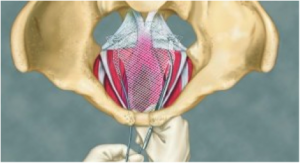 Pelvic Organ Prolapse (POP) affects approximately 30- 50 percent of all women between the ages of 49 and 80. It's a condition that usually occurs in women as they approach and move through menopause. Women who have given birth are more likely to be diagnosed with POP, as are Caucasian women, smokers, women who are overweight, and women who have suffered severe pelvic injuries.
Pelvic Organ Prolapse (POP) affects approximately 30- 50 percent of all women between the ages of 49 and 80. It's a condition that usually occurs in women as they approach and move through menopause. Women who have given birth are more likely to be diagnosed with POP, as are Caucasian women, smokers, women who are overweight, and women who have suffered severe pelvic injuries.
Surgical treatment is not always necessary, and one surgical procedure could put the patient at risk for serious complications. When doctors use transvaginal mesh to provide the support for tissues compromised by POP, they may be compromising the health of their patient.
Pelvic Organ Prolapse occurs when weakened muscles and connective tissues in the pelvis allow the uterus, bladder or bowels to drop into the vaginal canal. Sometimes this weakening is so minor that women don't feel any symptoms. In these cases, treatment is usually unnecessary, or doctors may prescribe Kegel exercises or lifestyle changes, which can reverse symptoms and prevent further weakening.
Some women experience more moderate to severe symptoms. In these cases, surgical procedures may be performed in order to correct POP. Prior to the use of transvaginal mesh, doctors used a patient's own tissues to support the weakened muscles. However, once transvaginal mesh was approved by the Food and Drug Administration (FDA), it became the medical device of choice for many surgical procedures to correct POP.
Transvaginal mesh used for POP was approved in 2002 under the FDAs 510(k) Clearance Process, which is a "fast-track approval" program for new devices that share similarities with similar pre-approved devices on the market. Unfortunately, vaginal mesh products do not perform as successfully as their similar mesh product counterpart, which is used to treat hernias.
Vaginal mesh erosion is the main culprit of the thousands of transvaginal mesh complications reported to the FDA since the early 2000s.
Complications associated with vaginal mesh can include:
- Erosion of mesh material into the vaginal tissues and/or other organs
- Protrusion of the mesh into the vagina
- Pain in the vaginal canal and/or pelvic region
- Pain or discomfort during sexual intercourse
- Incontinence
- Difficulty with bowel movements
- Unusual discharge or bleeding
It can often require more than one revision surgery in order to reverse any damages related to transvaginal mesh and there could be permanent health issues. Women with POP should understand their risk with regards to Pelvic Organ Prolapse and its treatment. Non-invasive surgeries should be used whenever possible, and if surgical intervention is necessary, women should be aware of the risks of vaginal mesh.
Guest blogger: Elizabeth Carrollton writes for Drugwatch.com.
Sources:
http://www.fda.gov/MedicalDevices/Safety/AlertsandNotices/ucm262435.htm
http://www.medscape.com/viewarticle/746285
![]() Prentice Women’s Hospital: Under the Northwestern Memorial Hospital Chicago, was recently named one of the top ten women's health providers by HealthCare Global Magazine. It was noted that the hospital provides a wide variety of services and specialized care just for women, through all stages of their lives- from gynecologic and pregnancy care to menopause and bone health. The Women's Health Research Institute has worked with Prentice on several programs including:
Prentice Women’s Hospital: Under the Northwestern Memorial Hospital Chicago, was recently named one of the top ten women's health providers by HealthCare Global Magazine. It was noted that the hospital provides a wide variety of services and specialized care just for women, through all stages of their lives- from gynecologic and pregnancy care to menopause and bone health. The Women's Health Research Institute has worked with Prentice on several programs including:
 Pelvic Organ Prolapse (POP) affects approximately 30- 50 percent of all women between the ages of 49 and 80. It's a condition that usually occurs in women as they approach and move through menopause. Women who have given birth are more likely to be diagnosed with POP, as are Caucasian women, smokers, women who are overweight, and women who have suffered severe pelvic injuries.
Pelvic Organ Prolapse (POP) affects approximately 30- 50 percent of all women between the ages of 49 and 80. It's a condition that usually occurs in women as they approach and move through menopause. Women who have given birth are more likely to be diagnosed with POP, as are Caucasian women, smokers, women who are overweight, and women who have suffered severe pelvic injuries. Women cyclists who set their bikes' handlebars lower than the saddle tended to show a degree of impaired genital sensation, researchers at Yale U reported. Among 41 competitive cyclists, the 19 who rode bikes with relatively low handlebars had, on average, significantly higher vibratory thresholds in the anterior vagina, compared with riders whose handlebars were level with the bike saddle, according to Marsha K. Guess, MD, and colleagues.
Women cyclists who set their bikes' handlebars lower than the saddle tended to show a degree of impaired genital sensation, researchers at Yale U reported. Among 41 competitive cyclists, the 19 who rode bikes with relatively low handlebars had, on average, significantly higher vibratory thresholds in the anterior vagina, compared with riders whose handlebars were level with the bike saddle, according to Marsha K. Guess, MD, and colleagues.